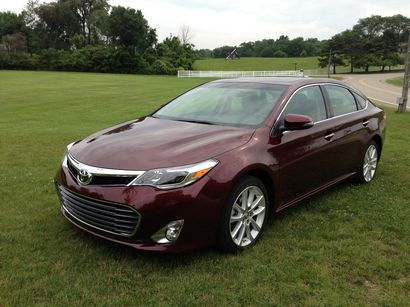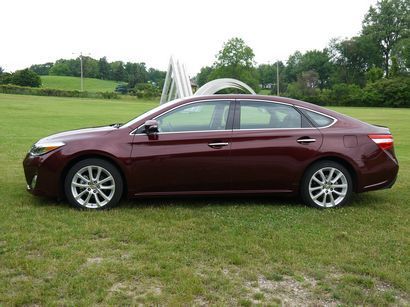Toyota raises the bar as we spend a week in the elegant new Avalon
Pros:
Standout styling
Spacious, quality interior
Quiet cabin and ride
Cons:
Some cheap interior trim pieces
Seats only give okay support
Bridging the gap
The Avalon was first introduced in 1994 as a 1995 model and, since that time, has served as the Toyoda City-based manufacturer's flagship sedan by bridging the gap between it and the Lexus brand.
As such, the full-size sedan reflected Toyota's traditional values: quality, reliability and practicality. It was also boring to look at and uninspiring to drive. In fact, for most of its life it could best be described as the world's nicest Buick - faint praise, indeed. Up until its third re-design in 2005, it was even available with that most American of touches - a front bench seat.
But that all changed on April 5, 2012 when, in a darkened upper room of the Javits Center, the 2013 Toyota Avalon made its world debut at the 2012 New York International Auto Show.
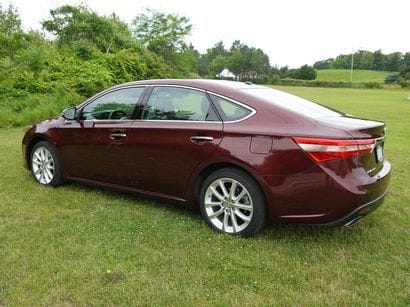
2013 Toyota Avalon XLE Touring
In terms of overall size, the fourth generation Avalon isn't that much different than its predecessor, although only one dimension, a 111-inch wheelbase, remains unchanged. Length and width and height (195.3 in., 72.2 in., and 57.3 in.) were all reduced by 2.3, 0.6 and 1.0 inches, respectively.
Significantly, the front and rear tread were increased (by 0.4 and 0.6 inches), for more stability while the front and rear overhangs were decreased (by 0.6 and 1.7 inches) – pushing the wheels out to the corners. Even more impressive is the fact that vehicle weight was reduced by giving the Avalon a better horsepower-to-weight ratio for improved performance.
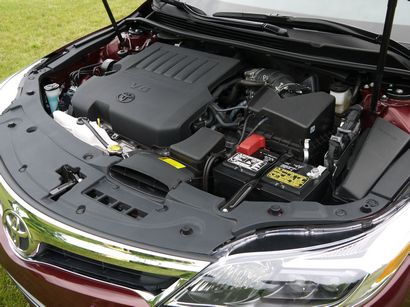
Speaking of performance, like all Avalons the V-6 engine in our tester was a carryover from the previous generation with Toyota adhering to port fuel injection, although direct injection is undoubtedly on the horizon. The result is an identical output of 268 horsepower and 248 lb.-ft. of torque. City fuel economy is up by 1 mpg to 21city while highway fuel economy is up by 2 mpg to 31 highway (our observed fuel economy mirrored these figures).

Styling
But none of these small changes on paper can prepare you for how much the stylists have managed to completely transform the Avalon. The new look is both sleek and sophisticated and, unlike its predecessor, it won't get lost in a parking lot full of cookie cutter midsize sedans.
Not only is the sheetmetal all new, but the 2013 Avalon bears no resemblance whatsoever to its predecessor. Up front, the upper grille and headlamp enclosures are narrower and sleeker, while both the front bumper and bland lower fascia have been replaced by a large and aggressive-looking lower air intake.
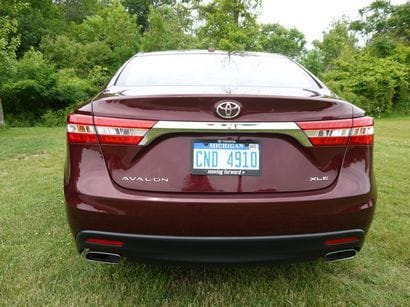
Along the sides, prominent upper and lower body creases are accentuated by pronounced wheel arches. In back, the previous model's eyebrow-shaped taillamps have been replaced by narrower horizontal units, while the decklid features a more aggressive rear lip.
Tying this all together is a steeply raked windshield and a sweeping, almost coupe-like, roofline.
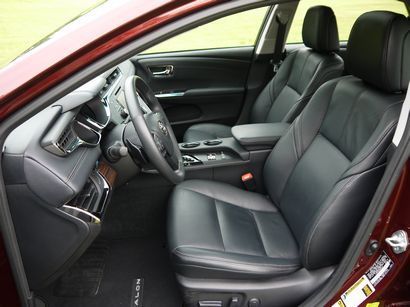
Interior
The interior itself is more Lexus than Toyota. A striking one-piece upper dash is separated from the lower dash area by the only cabin misstep: a too-glossy looking faux wood strip that, mercifully, is only repeated on the rear-facing portion of the center console. The rest of the trim surfaces feature smoked chrome-metallic accents
All surfaces are soft touch, with real stitching on the upper door and dash trim, as well as the dash extension over the instrument pod.
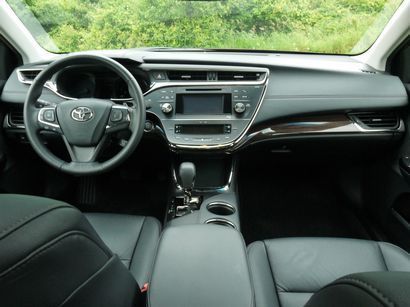
Despite the fact that the interior is smaller – going from 106.9 to 102.3 cubic feet and moving the Avalon down a rung in the EPA ladder from full-size to mid-size, Toyota has gone to great lengths to give occupants a feeling of spaciousness. The beltline has been lowered, the passenger-side dashboard features a concave design and the front seat's hip point was lowered by 0.4 inches for improved headroom. Lateral support was good, but the bottom cushion was a bit soft for my tastes.
At the same time, luggage capacity is now 16.0 cubic feet, an increase of 1.6 cubic feet over the 2012 model – the rear seat also folds down and features a small pass-through door to the trunk hidden behind the rear fold-down arm rest.

Typical for a Toyota, all controls, including those with capacitive touch (that come with feedback) on the center console, were within easy reach of the driver, intuitive and silky smooth in their operation. Driver visibility throughout the cabin was also excellent as even the rear three-quarters view is aided by a window located within the C-pillar.
A testament to the simplicity of its Entune infotainment system is that I was able to pair an iPhone to it without having to consult the owner's manual – a target that has become somewhat of a benchmark around here.

Speaking of Entune, all Avalons come standard with three color display screens that support the multi-information display, audio/navigation functions and climate control system. The Display Audio system, itself, is supported by a 6.1-inch touchscreen.
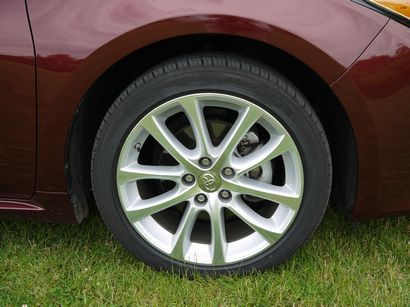
On the road
One of the targets of the Avalon's re-design was improved vehicle dynamics in order to improve the outgoing model's straight-line stability and handling. Toyota set about accomplishing this by adding strategically-placed welds, improving body bracing and adding high-strength steel in key areas.
In addition, coil spring rates and front and rear sway bar stiffness were increased, while the electric power steering system was recalibrated for better control and feedback.

The result of all this engineering goodness is the most driver-oriented Toyota sedan I have ever experienced. While some might complain that much of the plushness of the previous model has been sacrificed, the fact is that the new Avalon offers a flatter trajectory through corners while road noise to a minimum (through the use of acoustic glass and additional sound-deadening materials).
On-center steering feel is also excellent and the weight builds nicely as it moves through the curves. Straight-line stability is also impressive and on the interstate, unlike many vehicles in this class, I found that there was no need to constantly make corrections.

Avalon XLE Touring models (and up) also come equipped with three drive modes – Normal, Eco and Sport – available through a driver-selectable switch. When compared to the Normal mode, Sport offers enhanced throttle response and higher steering effort, while Eco alters the throttle and A/C power usage to boost fuel economy.
Speaking of throttle response, acceleration is brisk (squawking the front tires is possible before the traction control kicks in) and the brakes provide excellent feedback and are easy to modulate (a variable ratio brake pedal varies the initial and final pedal effort ratios) while bringing down the Avalon's decreased mass (155 pounds - from 3,616 to 3,461 on our XLE tester) with greater efficiency than a great many vehicles in its class.
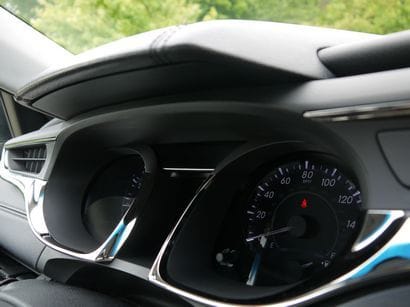
Pricing
As you might expect, the Avalon brings a high level of standard equipment to the table. Even in base XLE trim this includes all the power niceties including windows, locks, mirrors and front seats. Also standard is the aforementioned infotainment system, 17-inch alloy wheels, leather seating, smart key with pushbutton start.
Stepping up to the XLE Premium adds a moonroof, auto-dimming rearview mirror and Homelink.
Checking the box next to XLE Touring – like our tester – adds, among other things, 18-inch alloys, fog lights, navigation, Entune, leather steering wheel with paddle shifters (plus Sport and ECO mode driving settings) and Blind Spot Monitor with Rear Cross-Traffic Alert.

Adding to all that, the top-shelf non-hybrid Avalon Limited comes with HID headlamps and LED daytime running lights, auto-dimming outside mirrors, rain-sensing wipers, aluminum door sill scuff plates, navigation system, perforated leather seats (cooled in front and heated in back), a power rear window sunshade and, ta-dah!, "white ice" interior ambient lighting.
Pricing for non-hybrid Avalons starts at $32,195, including destination, for an XLE and can top out at over $44,000 for a fully decked-out Limited. Our nicely-equipped (first aid kit $29.00, carpeted floor and trunk mats $225) Moulin Rouge XLE Touring tester nearly split the difference, checking in at exactly $36,549.
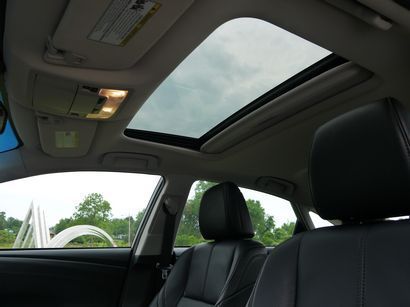
The Bottom Line
What we have with the 2013 Toyota Avalon is something of a revelation. By shedding pretty much all of its previous car-as-appliance approach along with an interior that, dare I say would look quite at home in a Lexus (that is, aside from those odd bits of fake wood trim).

Here at LotPro, we were, to say the least, pleasantly surprised at its metamorphosis. But even more intriguing is the fact that, at its introduction, Toyota noted that the Avalon "foreshadows the more compelling and passionate nature of future Toyota products."
Currently Avalon owners may not be over pleased with these changes, but those drivers seeking involvement will be. We also predict that many more potential buyers looking for this plus the quality and reliability Toyota is known for with more style than they're used to seeing from the brand will be making their way to Toyota new car dealer showrooms.


